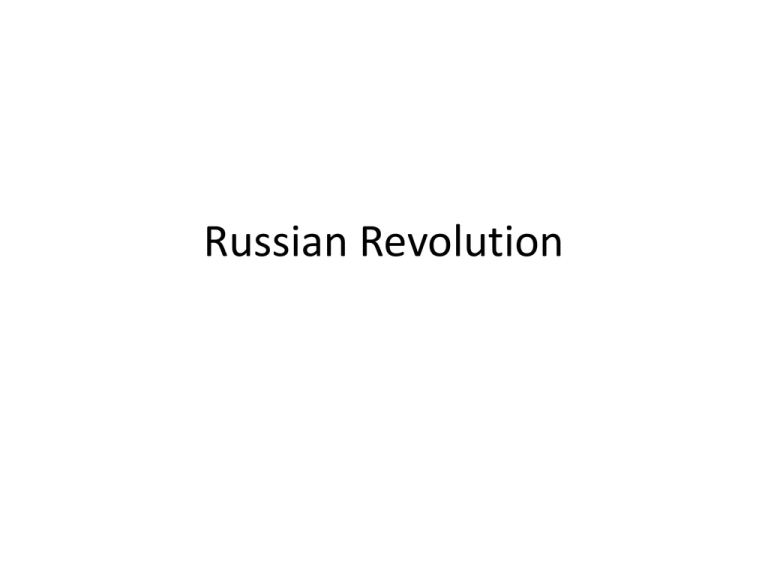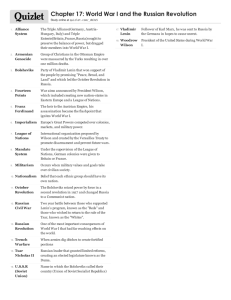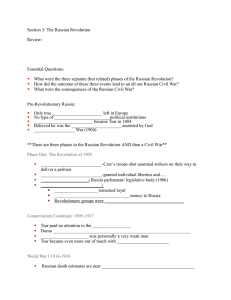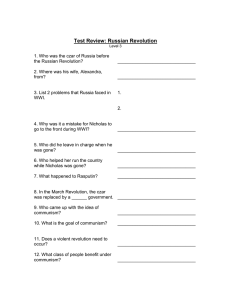Russian Revolution
advertisement

Russian Revolution Agenda 1. 2. 3. 4. 5. Bell Ringer: Review Russian Rev, the beginning (5) Lecture: Russian Revolution. (25) Primary Document Analysis, Bolshevik Revolution. (10) Imperialism Review (10) Review for test on Wednesday/Friday 1. 2. Multiple Choice Essays- 3, pick 2 6. After Spring Break Schedule During Titan Time: Cohort leaves at 11:40, AP Review strategies and review for test Q and A. Agenda 1. Bell Ringer: What was the physical and emotional toll on the troops during World War I? 2. Group AP Multiple Choice samples. (10) 3. Lecture: End of War and Russian Revolution. (20) 4. Changing History in Russia (5). 5. Primary Document Analysis, Bolshevik Revolution. (10) 6. Land, Peace, and Bread Activity. (15) 7. Treaty of Versailles Activity. (10) Students will examine the impact of the Russian Revolution and the formation of Communism as a political and economic theory. Alexander III • Takes over after father is assassinated. • Strengthen autocracy, orthodoxy, and nationality. • Censorship codes on all written records. • Even schools were monitored for political dissent. • Pogroms – organized violence against Jews to unify Russian Culture. Nicholas II • Tsar of the Romanov family takes over in 1894. • Refused to surrender any power. • Industry slow to take hold. • Trans-Siberian railway constructed in 1904, Russia is a leading steel industry. Industrialization and Revolution • More factories = poor working conditions, low wages, and child labor. • Two Revolutionaries: – 1903, Mensheviks broad base of popular support for a revolution. – Bolsheviks, small number of committed revolutionaries. • Lenin would lead the Bolsheviks, but flee when he faced arrest in early 1900s. International Affairs • Russo-Japanese War – Japan attacks Russia over broken treaties. They manage to take Manchuria. • Bloody Sunday – 200,000 show up peacefully asking for better wages and working conditions. – Tsar is not at home, guards fire on Civilians, killing 1,000. Russia and World War I • Weak Generals and lack of artillery lead to the civilian population revolting. • Tsar Nicholas attempts to rule near the front, to manage military affairs. • Wife runs government, but follows the elusive Rasputin. • War destroys morale, and with food and supplies dwindling, along with inflation, people began a revolution. The March Revolution • It began with a strike in 1917 over food shortages. • Soldiers given the task of shooting the rioters would join them instead. • The Tsar would abdicate his throne, and a provisional government was interred. • The provisional government continues war and bad policies, and a more radical revolution follows with Lenin. Vladimir Lenin • Became a revolutionary after brother was killed. – He was attempting to assassinate the Tsar. • His own plot would lead to Lenin fleeing from Russia in the early 1900s. • Becomes “Father of the Revolution” The Bolshevik Revolution • The provisional government falls. • “Peace, land and bread” • Lenin’s rallying cry resonated with the people. • Over in a few hours with the storming of the Winter Palace, culminating in the arrest of the former government leaders. Lenin in power • All farmland is distributed among peasants. • Control of factories given to the workers. • Signed a truce with Germany. • Brest-Litovsk treaty signed, giving Russian territory to Germany (Poland). New Philosophy, New Russia • New Economic Policy – Small scale capitalism, peasants can sell their crops instead of giving to the government. – Encouraged foreign investment. – Major industry controlled by the government. • Eventually they would move towards Communism, complete government control. Lenin vs. Stalin • Lenin advocated pure Communism, handing over control of farms and factories to the “people” but all goods were sent to the government for redistribution. • Stalin would take power soon after the death of Lenin. He would force Trotsky into exile, and change Communism to a totalitarian policy. Now you see him Now you don’t Now you see them Now you Don’t





